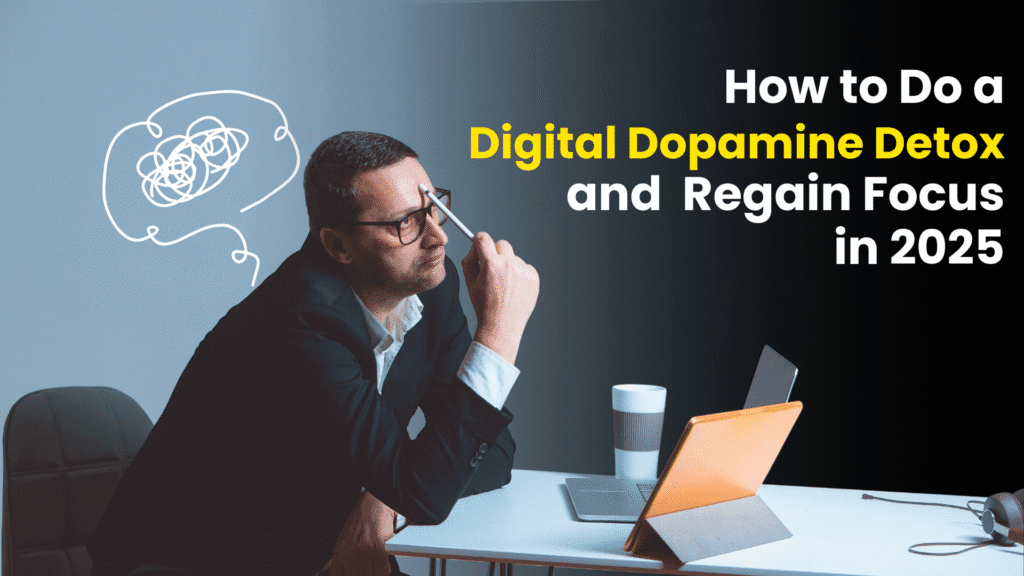
How to Do a Digital Dopamine Detox and Regain Focus in 2025
Welcome to the Age of Digital Overload
We live in an era where instant gratification is just a tap away. From endless scrolling on social media to non-stop notification pings, our brains are wired for dopamine hits—the feel-good chemical that’s hijacking our attention span. The average person now checks their phone over 90 times a day, and productivity has taken a nosedive.
A Digital Dopamine Detox isn’t just a trend—it’s a powerful method to reset your brain, improve concentration, and reclaim control over your time. This article will walk you through the science behind dopamine, how digital stimuli affect our minds, and what you can do to regain focus in a distraction-heavy world.
What is Dopamine and Why Should You Care?
Dopamine is a neurotransmitter that plays a key role in the brain’s reward system. It reinforces behaviors that provide pleasure or a sense of accomplishment—like receiving a text message, getting likes on Instagram, or finishing a level in a game.
However, constant digital stimulation leads to dopamine desensitization. The more we feed our brains with micro-rewards, the less sensitive we become, requiring more intense stimulation to feel satisfied. This is why digital addiction is becoming a silent epidemic.

How Digital Devices Hijack Your Brain
Every notification, pop-up, like, and message is a mini dopamine hit. Over time, this leads to a dopamine loop—a vicious cycle where your brain constantly craves more input and novelty. Here’s how digital devices are rewiring your brain:
Reduced Attention Span: Multitasking between tabs, apps, and tasks leads to shallow focus.
Sleep Disruption: Blue light and late-night scrolling disrupt melatonin production.
Mental Fatigue: Cognitive overload from constant switching drains mental energy.
Lack of Deep Work: Creative, meaningful tasks are replaced with surface-level scrolling.
Signs You Need a Digital Dopamine Detox
You might need a dopamine detox if you notice the following:
You feel anxious when you’re away from your phone.
You check social media first thing in the morning and last thing at night.
You can’t stay focused on a single task for more than 10 minutes.
You find yourself mindlessly scrolling even when you’re not interested.
You’re constantly chasing productivity but not completing meaningful work.
The Science Behind a Dopamine Detox
A dopamine detox isn’t about eliminating dopamine completely—that’s biologically impossible and unhealthy. It’s about avoiding over-stimulation for a set period so your brain can reset its reward system.
When you eliminate high-stimulation activities like YouTube, social media, online shopping, video games, or even junk food, your brain re-learns how to find pleasure in low-stimulation, high-value tasks like reading, deep work, or face-to-face conversations.
According to researchers from Stanford and Harvard, even 24 hours without stimulation can begin to rewire your brain’s baseline dopamine sensitivity.

Step-by-Step Guide to Your Digital Dopamine Detox
Step 1: Identify Your Triggers
Make a list of your top dopamine-inducing digital activities. These could include:
Instagram
YouTube binge sessions
TikTok or Reels
Constant email checking
Mindless scrolling through Reddit or news feeds
Be brutally honest—knowing your triggers is key to eliminating them.
Step 2: Set a Time Frame
Start with a 24-hour detox and gradually build up to 48 hours or even a full week. For beginners, we recommend:
Sunday detox: One full day with no screens except for emergencies.
Digital-free mornings: No phone for the first 2 hours after waking up.
Step 3: Replace High-Dopamine Activities
You can’t just remove stimulation—you must replace it with meaningful, low-stimulation tasks. Try:
Reading a physical book
Journaling your thoughts
Going for a walk without your phone
Practicing mindfulness or meditation
Drawing, painting, or any creative task
Deep work on your most important goal
Step 4: Create Friction for Bad Habits
Make it harder to access your digital temptations:
Delete addictive apps temporarily
Use grayscale mode on your phone
Keep your phone in another room
Use blockers like Freedom or Cold Turkey
Turn off all non-essential notifications
Step 5: Evaluate and Reflect
After your detox, reflect on these questions:
How did I feel without constant stimulation?
Was I more focused or less anxious?
What activities brought me real joy?
What will I change in my digital routine?
Document your experience in a journal or share it with your accountability partner or group.
Long-Term Digital Hygiene Tips
A detox is just the beginning. Long-term focus requires digital boundaries and smart systems:
Schedule screen time just like meetings
Batch notifications and check messages only twice a day
Use focus apps like Notion, Obsidian, or Minimalist
Apply the 80/20 rule to your digital life—keep the 20% that adds value
Block time for deep work every day (no notifications allowed)
Benefits of a Digital Dopamine Detox
Once you successfully complete a detox, you’ll experience:
Enhanced focus and mental clarity
Better sleep and energy levels
Improved mood and reduced anxiety
More time for relationships and real hobbies
Stronger ability to complete meaningful work
Your mind feels lighter, your thoughts become sharper, and you realize that the best things in life don’t come with push notifications.

Conclusion: Reclaim Your Attention, Reclaim Your Life
In a world where distraction is the new normal, staying focused is your superpower. The Digital Dopamine Detox isn’t just a productivity hack—it’s a survival tool for the modern mind.
By resetting your brain’s reward system, you not only reclaim your time but also rediscover the joy in deep work, real connection, and meaningful living.
Take the first step today. Put your phone down. Breathe. Focus.

